With a few essential supplies and some creativity, you can create stunning DIY glass art pieces at home. In this comprehensive guide, we will delve into various glass painting styles, essential techniques, and tips for success.
- Discover various glass painting styles to explore.
- Learn essential techniques such as outlining, shading, and blending.
- Understand the importance of properly preparing the glass surface.
- Explore advanced techniques such as etching and sandblasting.
- Gain inspiration for showcasing your glass artistry.
Getting Started with Glass Painting
If you’re new to glass painting, it’s important to have the right supplies on hand. Here are some essential glass painting supplies to get you started:
- Glass pieces (such as vases, jars, or ornaments)
- Glass paint (water-based or enamel)
- Brushes (small and medium-sized)
- Palette or mixing tray
- Paint thinner (if using enamel paint)
- Protective gloves and eyewear
If you’re a beginner, it may be helpful to start with simple designs and practice your brush techniques. You can also experiment with different types of glass paint and surfaces to see what works best for you. Remember to work in a well-ventilated area and take precautions to protect yourself and your workspace.

There are various styles of glass painting to experiment with, each with its unique characteristics and techniques. Here are two popular styles to explore:
Stained Glass Painting
Stained glass painting is a centuries-old technique that involves painting on a clear glass surface with pigmented colors that are then fused together to create a stained glass effect. This technique is commonly used in creating decorative windows in churches or homes. Artists typically use a lead frame to outline the design and fill in the sections between the lead lines with color. The result is a beautiful, intricate, and colorful piece of art.
Reverse Glass Painting
Reverse glass painting is unique because the artist paints on the backside of the glass surface. When viewing the finished artwork from the front, the design appears as if it’s floating within the glass. This technique involves painting the design in layers, starting with the background colors and gradually adding detail and texture. It requires a steady hand and a good understanding of color theory to achieve the desired effect.

Other glass painting styles to explore include enamels, which involve painting on a transparent or translucent glass surface with pigmented enamel paints. Glass etching is another technique that involves using acid or sandblasting to create designs or patterns on the surface of the glass. Experimenting with different styles can help you refine your technique and develop your own unique artistic voice.
Essential Techniques for Glass Painting
If you want to create beautiful and vibrant designs on a glass surface, you need to master some essential glass painting techniques. Here are some of the fundamental techniques you need to know:
- Outlining: Creating a clear outline for your design is the first step to a successful glass painting. You can use a fine-tip brush and black paint or a specialized glass-painting pen for the outline.
- Shading and Blending: Adding depth and dimension to your design is essential for creating realistic and visually appealing glass paintings. You can use a variety of shading and blending techniques, including stippling, cross-hatching, and feathering.
- Color Layering: Layering colors on a glass surface can create a dynamic and unique effect. Start with a light base color and build up the layers gradually, using darker shades to add depth and texture.
- Dry Brushing: Dry brushing is a technique that involves applying paint to a brush and then removing most of it with a cloth or paper towel. This technique creates a textured, almost uneven effect, which can be perfect for adding texture to your glass painting.
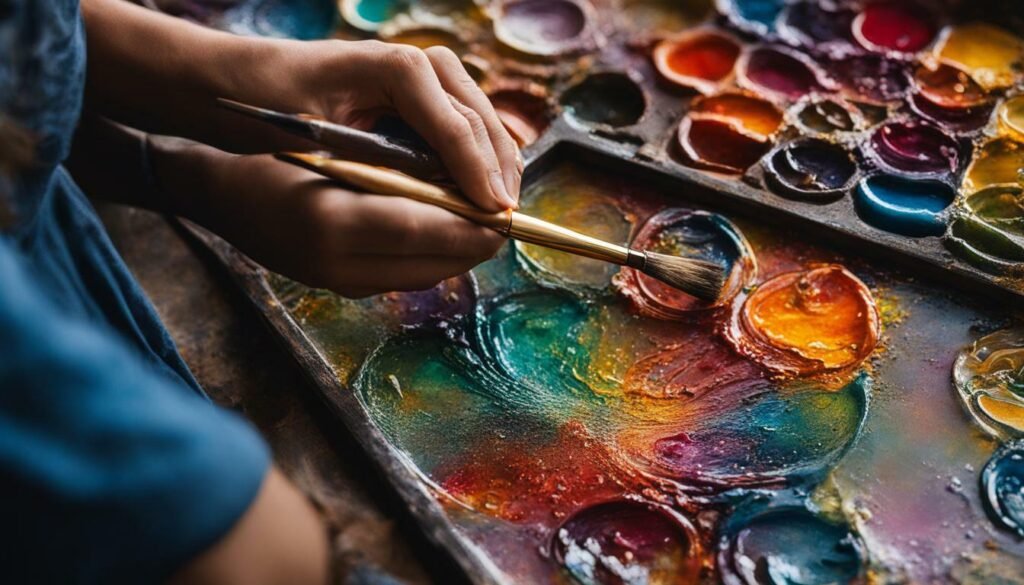
Remember, practice makes perfect when it comes to glass painting. Don’t be afraid to experiment with different techniques and styles to find your own unique approach. With patience and dedication, you can create stunning glass art pieces that are sure to impress.
Preparing the Glass Surface
Before starting your glass painting project, it’s crucial to prepare the glass surface properly to ensure optimal results. Here are some tips to help you get started:
- Clean the glass thoroughly with soap and water to remove any dirt, dust, or fingerprints. Dry the glass with a lint-free cloth or paper towel.
- Use a glass cleaner or rubbing alcohol to remove any stubborn stains or residues. Wipe the glass clean and let it dry completely.
- Apply a layer of glass primer to the surface before painting to enhance adhesion and prevent chipping or peeling. Follow the manufacturer’s instructions for best results.
- Choose the right type of glass for your painting project. Clear glass is ideal for transparent and translucent effects, while opaque glass can provide a more solid and vibrant base color.

With these tips in mind, you’ll be well on your way to creating stunning glass paintings. Don’t be afraid to experiment with different techniques and styles to unleash your creativity!
Section 6: Selecting the Right Paints for Glass Painting
When it comes to glass painting, not all paints are suitable for the task. It’s important to choose the right paints to achieve the desired effect on your glasswork. Here are some tips on selecting the right paints for your glass painting project:
- Consider the type of glass: Different types of glass require different types of paint. For example, non-porous glass, such as ceramic glass, needs different paints than porous glass, like stained glass. Research the type of glass you will be painting on to determine the appropriate paints.
- Choose high-quality paints: To achieve vibrant and long-lasting colors, invest in high-quality paints designed for glass painting. Cheaper paints may not adhere well to the glass or may fade over time.
- Try different types of paints: Experiment with different types of paints, such as transparent, opaque, or metallic, to achieve different effects. Transparent paints can create a stained glass effect, while opaque paints can create a solid color.
- Get inspired: Look for inspiration in art supply stores or online to discover new paint colors and combinations. Seeing what others have created can spark your own creativity.

Having the right paints is essential to creating beautiful glass art pieces. By following these tips, you can choose the right paints for your project and be on your way to creating stunning DIY glass paintings.
Tools and Brushes for Glass Painting
Choosing the right tools and brushes is essential for achieving precision in your glass painting. Here are some essential glass painting supplies you should have in your toolkit:
- Glass paint in various colors
- Paintbrushes in different sizes and shapes, including liners and round brushes
- Palette knives for scraping and mixing paint
- Stencils for creating precise designs
- Masking tape for creating clean edges
When selecting your glass paintbrushes, look for brushes with soft bristles that can easily glide over the surface of the glass. You can also consider purchasing a brush set that includes a wide range of brush sizes and shapes for more versatility in your painting.
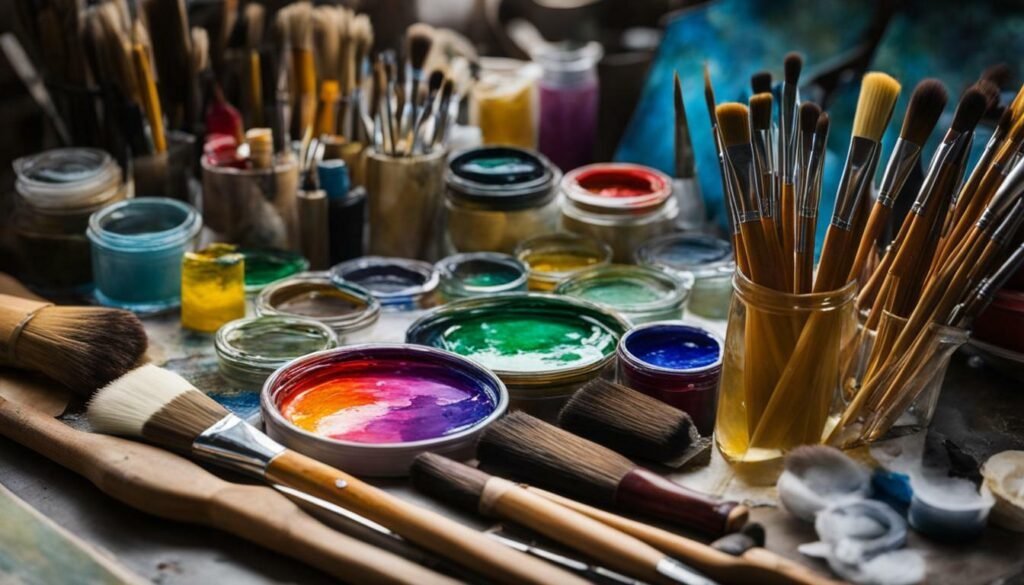
For more intricate and detailed work, a liner brush is recommended. This long, thin brush creates fine lines and details with ease. Round brushes are also ideal for creating details and filling in small areas. The palette knife is perfect for blending colors and creating textures on your glass surface.
Creating Depth and Texture in Glass Painting
Adding depth and texture to your glass paintings can bring a new dimension to your artwork. Here are some techniques you can use:
- Sgraffito: This involves scratching off the paint to reveal the glass underneath, creating a textured effect.
- Stippling: Using a stippling brush or a toothbrush, you can create a speckled effect that mimics the look of sandblasting.
- Embossing: By applying a thick layer of paint and creating texture with a palette knife, you can create an embossed effect on your glass surface.
Experiment with these techniques to explore new possibilities in your glass painting style. Remember to use the right tools and brushes to achieve the desired effect.
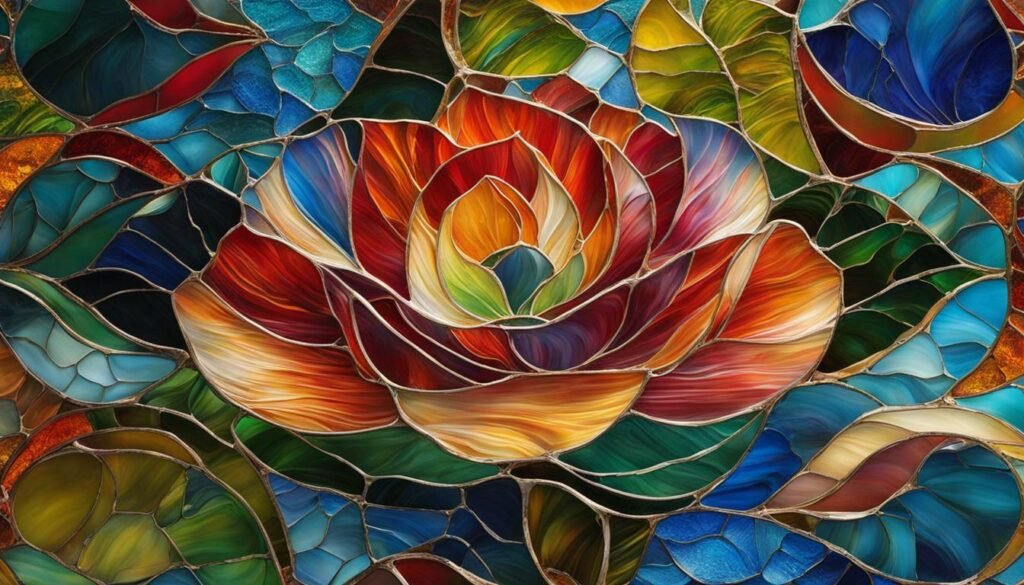
When it comes to glass painting, safety should always be your top priority. Here are some tips to help you stay safe while enjoying this art form:
- Always wear protective gear, such as gloves and goggles, when handling glass and paints.
- Work in a well-ventilated area to avoid inhaling any fumes.
- Store your glass painting supplies properly and out of reach of children and pets.
- Never eat or drink while working with glass and paints.
- Dispose of any leftover paints and chemicals responsibly, following local guidelines.
By following these simple guidelines, you can ensure a safe and enjoyable glass painting experience. Now that you know how to stay safe, let’s move on to some tips and techniques for successful DIY glass painting.
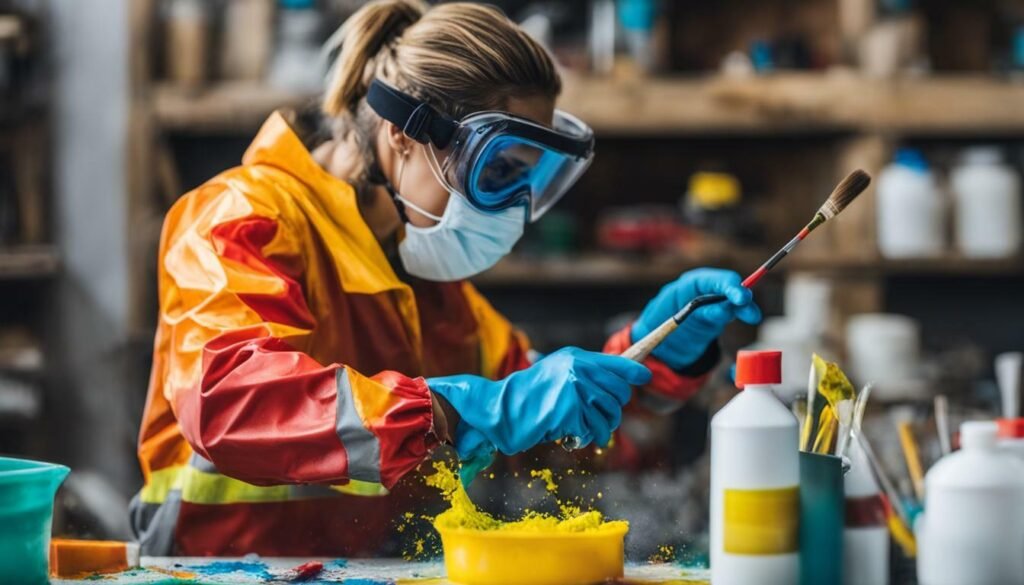
If you’re new to glass painting, these tips can help you achieve success:
- Start with simple designs and gradually work your way up to more complex ones.
- Practice your brush strokes on a piece of paper before starting on your glass piece.
- Use a light touch when applying paint to avoid smudging.
- Clean your brushes thoroughly after each use to prevent any residue from contaminating your next project.
- Experiment with color combinations to create unique and eye-catching designs.
- Consider using stencils or tracing paper to help create more precise designs.
- Allow your glass piece to dry completely before handling or displaying it.
Whether you’re a beginner or an experienced artist, these tips can help you create stunning glass art pieces that you can be proud of. Don’t be afraid to try new techniques and let your creativity shine!

Whether you’re a beginner or an experienced artist, there are some tips and tricks that can help you achieve success in your glass painting projects. Here are some things to keep in mind:
- Start with clean, dry glass for best results.
- Use a paint that is specifically designed for glass painting to ensure good adhesion to the surface.
- Be patient and take your time. Rushing can lead to mistakes that are difficult to correct.
- Experiment with different color combinations, shading techniques, and styles to find what works best for you.
- Don’t be afraid to make mistakes. Every artist makes mistakes, and they can often lead to new and interesting ideas.
- Practice regularly to improve your skills and gain confidence in your abilities.
By following these tips and incorporating your own creativity, you can achieve beautiful and unique glass art pieces through DIY glass painting.
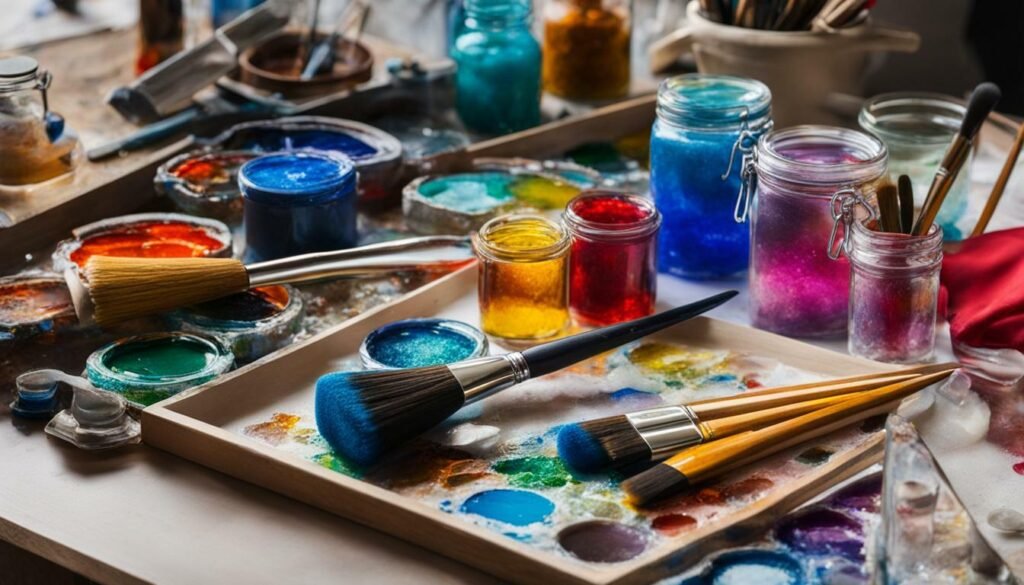
Once you have mastered the essential techniques and styles of glass painting, you may want to explore more advanced techniques to take your artistry to the next level. Here are some techniques to try:
- Etching: This technique involves using acid or abrasive materials to create a frosted or textured effect on the glass surface. You can create a stencil or freehand design to etch into the glass.
- Mixed media: Incorporating other materials such as beads, wire, or found objects can add texture and depth to your glass painting. Experiment with different combinations to create unique and eye-catching pieces.
- Sandblasting: This technique uses high-pressure air and sand to carve intricate designs into the glass. You can use stencils or freehand techniques to create a variety of effects.
Remember to practice safety precautions when attempting advanced techniques, such as wearing protective equipment and following instructions carefully. These techniques may require additional supplies and equipment, so be sure to research and acquire the necessary materials before starting your project.
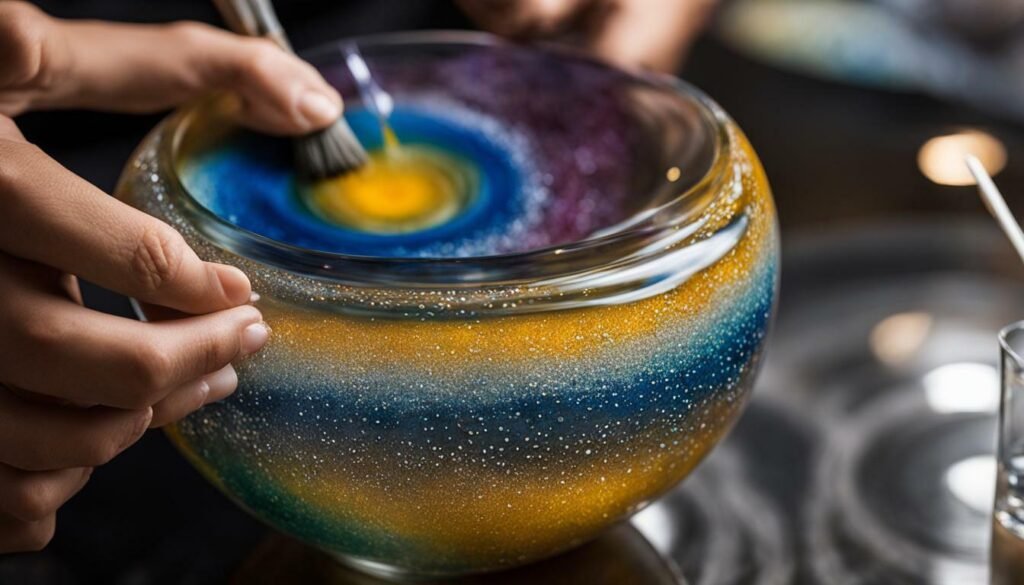
Getting inspiration for advanced techniques can come from anywhere – nature, architecture, or even your own imagination. With advanced techniques, you can take your glass painting to new levels of creativity and produce stunning works of art that showcase your unique style and skill.
Showcasing Your Glass Artistry
Now that you have honed your glass painting skills and created beautiful DIY glass art pieces, it’s time to showcase your artistry.
Create Functional Pieces
Consider using your glass paintings to create functional pieces that can be used in your home or given as gifts:
- Paint a vase or jar to use as a one-of-a-kind container for flowers or other decor.
- Use glass paints to decorate drinkware or plates for a unique table setting.
- Paint a mirror frame or picture frame to add a personal touch to your decor.
Explore Decorative Applications
Looking for more creative ways to showcase your glass art? Consider these decorative applications:
- Create a stained glass window by painting multiple pieces of glass and joining them together with lead strips.
- Paint a glass sun catcher to hang in a window and catch the light.
- Use glass paints to create custom ornaments or decorations for holidays or special occasions.
No matter how you choose to showcase your glass art, be proud of your creations and share them with others. Who knows, your art may inspire others to try their hand at glass painting too!
FAQ
What are the essential materials needed for glass painting?
To get started with glass painting, you will need glass painting supplies such as glass paints, brushes, a palette, and a clean glass surface to paint on.
What are some popular glass painting styles?
There are various glass painting styles to explore, including stained glass painting and reverse glass painting. Each style has its own unique characteristics and techniques.
What are the fundamental techniques in glass painting?
Glass painting techniques include outlining, shading, blending, and other skills that allow you to create detailed and vibrant designs on glass surfaces.
How do you prepare the glass surface before painting?
Properly preparing the glass surface is crucial for achieving optimal results. This involves cleaning the glass, priming it if necessary, and selecting the right type of glass for your project.
What type of paints are suitable for glass painting?
Not all paints are suitable for glass painting. You should use specialized glass paints that are designed to adhere to glass surfaces and withstand heat curing or air drying.
What tools and brushes are needed for glass painting?
Choosing the right tools and brushes is essential for achieving precision in glass painting. Brushes, palette knives, and other tools can enhance your techniques and help create the desired effects on glass.
How can you create depth and texture in glass painting?
Adding depth and texture to your glass art can enhance its visual appeal. Techniques such as sgraffito, stippling, and embossing can bring a three-dimensional quality to your glass paintings.
What safety precautions should I take when glass painting?
Safety is important when working with glass and paints. Guidelines include handling materials carefully, ensuring proper ventilation, and wearing protective gear like gloves and goggles.
Do you have any tips for successful glass painting?
Whether you’re a beginner or an experienced artist, tips such as color blending techniques and design composition can help enhance your skills and creativity in glass painting.
How do I care for my glass paintings?
Proper care and maintenance are essential for preserving the beauty and longevity of your glass paintings. This includes cleaning them correctly, displaying them safely, and protecting them from damage.
Are there advanced glass painting techniques to explore?
Once you have mastered the basics, you can venture into more advanced glass painting techniques such as etching, sandblasting, and incorporating mixed media for more creative and unique artworks.
How can I showcase my glass artistry?
This section will inspire you with creative ideas for showcasing your glass artistry. From creating functional pieces like vases and stained glass windows to exploring decorative applications, you can find ways to display and share your beautiful glass paintings.
